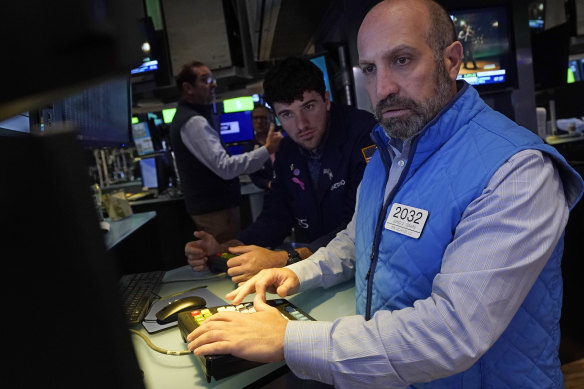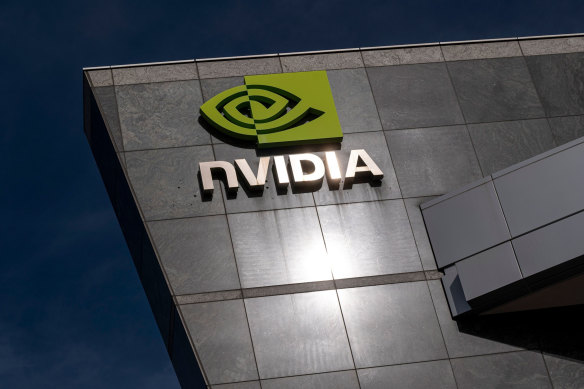ASX set to rise as Wall Street brightens; Nvidia results on tap
Save articles for later
Add articles to your saved list and come back to them any time.
Wall Street is rising as the pressure that’s built on stocks recently from the bond market relaxed a bit.
The S&P 500 was 1.2 per cent higher in afternoon trading, trimming its loss for what’s so far been a dismal August. The Dow Jones was up 0.6 per cent and the Nasdaq composite rallied 1.7 per cent. The Australian sharemarket is set to rise, with futures at 5.04am AEST pointing to a gain of 16 points, or 0.2 per cent, at the open. The ASX added 0.4 per cent on Wednesday.
Wall Street is having a rare strong session in August. Credit: AP
Big Tech stocks and others that benefit from easier interest rates led the way. They got some relief as the 10-year Treasury yield eased back further from its highest level since 2007 after a report suggested the surprisingly resilient US economy may be cooling in August.
A 2.2 per cent gain for Apple’s stock and 1.7 per cent climb for Microsoft shares were two of the strongest forces pushing the S&P 500 upward.
Nvidia, another one of the market’s most influential stocks, was 2.8 per cent higher ahead of its profit report scheduled to come out after trading ends. It’s a pivotal test for the entire stock market because it could show whether the frenzy around artificial-intelligence technology that’s helped to lift Wall Street this year is deserved or overdone.
Expectations are immense after Nvidia stunned Wall Street three months ago by predicting it would make roughly $US11 billion in revenue during the three months through July. That was nearly $US4 billion more than analysts had been forecasting and would be a 64 per cent leap from its numbers a year earlier.
The announcement set off a rush across Wall Street. Stocks of AI-related companies soared, and investors tried to count how many times a CEO could mention “AI” in an earnings call. Nvidia’s stock has more than tripled this year so far, and it will need to meet the much higher expectations around it to justify its big move.
Much of Wall Street is expecting Nvidia’s earnings report to meet forecasts, and its stock has already climbed more than 7 per cent this week in anticipation of it. Because Nvidia is one of the stock market’s largest companies, its moves pack more weight on the S&P 500 and other indexes than smaller stocks.
A big focus will be on what Nvidia says about its revenue for the current quarter. Expectations for that are even bigger. Analysts are forecasting its third-quarter revenue will more than double to $US12.59 billion from a year earlier.
Nvidia and a just a handful of other companies were behind the majority of the S&P 500’s gains earlier this year. Many of those “Magnificent Seven” stocks were benefiting from the AI frenzy as well.
They’ve been under more pressure recently, as yields crank higher in the bond market. When bonds are paying more in interest, investors feel less need to pay high prices for stocks and other investments that can swing sharply in price.
Markets are eagerly awaiting Nvidia’s result.Credit: Bloomberg
Treasury yields eased Wednesday, taking off some of that pressure. The 10-year Treasury yield fell back further from its highest level since 2007, down to 4.20 per cent from 4.33 per cent late Tuesday.
A preliminary reading of US services and manufacturing businesses eased to a six-month low, sending yields lower across the bond market. The measure of output from S&P Global Market Intelligence still indicated growth, but less as inflation and higher interest rates bite into activity.
“A near-stalling of business activity in August raises doubts over the strength of US economic growth in the third quarter,” said Chris Williamson, chief business economist at S&P Global Market Intelligence.
For now, softer-than-expected data on the economy may be good for markets. That’s because a string of surprisingly strong reports recently has raised expectations for the Federal Reserve to keep interest rates higher for longer. The Fed has already hiked its main interest rate to the highest level since 2001 in hopes of grinding down high inflation.
High rates work by slowing the entire economy and hurting prices for investments, and they’ve helped inflation to ease since it peaked above 9 per cent last summer. But a still-solid job market and spending by US households threaten to make it difficult for inflation to come down the last percentage point to the Fed’s target of 2 per cent.
That’s why the main event of the week for markets could be a speech on Friday by Fed Chair Jerome Powell. He will be speaking at a Jackson Hole, Wyoming, event that’s been the setting for major policy announcements by the Fed in the past.
The hope among traders has been that the Fed has already hiked rates for the final time this cycle and that it will begin cutting rates early next year. But such hopes have been diminishing with each stronger-than-expected report on the economy that’s come in recently.
The two-year Treasury yield, which closely tracks expectations for the Fed, has also jumped recently, though it eased back like the 10-year yield on Wednesday. It fell to 4.95 per cent from 5.05 per cent.
On Wall Street, clothing retailer Abercrombie & Fitch surged 23.4 per cent after reporting strong second-quarter financial results.
Toll Brothers rose 3.8 per cent after the homebuilder reported stronger profit than expected. It earlier had struggled as higher mortgage rates hurt the entire housing industry.
Foot Locker tumbled 30.6 per cent after reporting weaker profit for the latest quarter than expected. The company also paused its dividend and cut its financial forecasts for the full year, describing a “still-tough consumer backdrop.”
Shares of companies that make products sold in Foot Locker stores were also weak. Nike fell 2.6 per cent.
In markets abroad, stock indexes were mixed across Europe and Asia.
AP
The Market Recap newsletter is a wrap of the day’s trading. Get it each weekday afternoon.
Most Viewed in Business
From our partners
Source: Read Full Article



